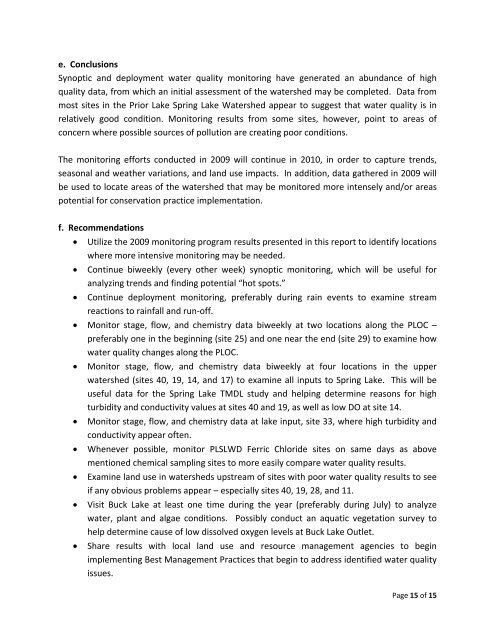Prior Lake - Spring Lake Watershed District 2009 Water Quality ...
Prior Lake - Spring Lake Watershed District 2009 Water Quality ...
Prior Lake - Spring Lake Watershed District 2009 Water Quality ...
You also want an ePaper? Increase the reach of your titles
YUMPU automatically turns print PDFs into web optimized ePapers that Google loves.
e. ConclusionsSynoptic and deployment water quality monitoring have generated an abundance of highquality data, from which an initial assessment of the watershed may be completed. Data frommost sites in the <strong>Prior</strong> <strong>Lake</strong> <strong>Spring</strong> <strong>Lake</strong> <strong><strong>Water</strong>shed</strong> appear to suggest that water quality is inrelatively good condition. Monitoring results from some sites, however, point to areas ofconcern where possible sources of pollution are creating poor conditions.The monitoring efforts conducted in <strong>2009</strong> will continue in 2010, in order to capture trends,seasonal and weather variations, and land use impacts. In addition, data gathered in <strong>2009</strong> willbe used to locate areas of the watershed that may be monitored more intensely and/or areaspotential for conservation practice implementation.f. Recommendations• Utilize the <strong>2009</strong> monitoring program results presented in this report to identify locationswhere more intensive monitoring may be needed.• Continue biweekly (every other week) synoptic monitoring, which will be useful foranalyzing trends and finding potential “hot spots.”• Continue deployment monitoring, preferably during rain events to examine streamreactions to rainfall and run‐off.• Monitor stage, flow, and chemistry data biweekly at two locations along the PLOC –preferably one in the beginning (site 25) and one near the end (site 29) to examine howwater quality changes along the PLOC.• Monitor stage, flow, and chemistry data biweekly at four locations in the upperwatershed (sites 40, 19, 14, and 17) to examine all inputs to <strong>Spring</strong> <strong>Lake</strong>. This will beuseful data for the <strong>Spring</strong> <strong>Lake</strong> TMDL study and helping determine reasons for highturbidity and conductivity values at sites 40 and 19, as well as low DO at site 14.• Monitor stage, flow, and chemistry data at lake input, site 33, where high turbidity andconductivity appear often.• Whenever possible, monitor PLSLWD Ferric Chloride sites on same days as abovementioned chemical sampling sites to more easily compare water quality results.• Examine land use in watersheds upstream of sites with poor water quality results to seeif any obvious problems appear – especially sites 40, 19, 28, and 11.• Visit Buck <strong>Lake</strong> at least one time during the year (preferably during July) to analyzewater, plant and algae conditions. Possibly conduct an aquatic vegetation survey tohelp determine cause of low dissolved oxygen levels at Buck <strong>Lake</strong> Outlet.• Share results with local land use and resource management agencies to beginimplementing Best Management Practices that begin to address identified water qualityissues.Page 15 of 15




